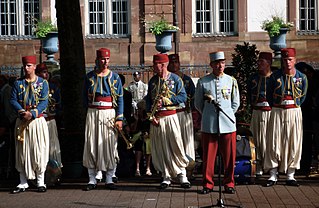
A tirailleur, in the Napoleonic era, was a type of light infantry trained to skirmish ahead of the main columns. Later, the term "tirailleur" was used by the French Army as a designation for indigenous infantry recruited in the French colonial territories during the 19th and 20th centuries, or for metropolitan units serving in a light infantry role.
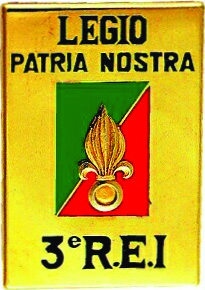
The 3rd Foreign Infantry Regiment is an infantry regiment of the Foreign Legion in the French Army. The regiment is stationed in French Guiana. Its mission includes the protection of the Centre Spatial Guyanais, a European Space Agency (ESA) facility.
The 19th Army Corps was a corps of the French army. In December 1870, the Tours delegation created the 19th Army Corps which was formed in Alençon. It was recreated by decree of the JO of August 13, 1874, it brought together the various military units of Algeria. It constituted the nucleus of the Army of Africa.
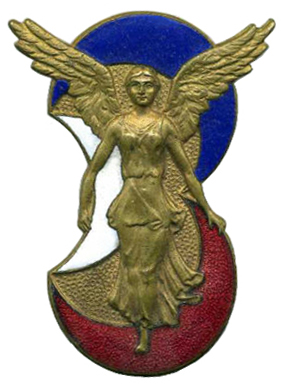
The 3rd Algerian Infantry Division was an infantry division of the Army of Africa which participated in World War II.

The 2nd Foreign Infantry Regiment is an infantry regiment of the Foreign Legion in the French Army. The regiment is one of two mechanized infantry regiments of the 6th Light Armoured Brigade.

The Régiment d'infanterie chars de marine in French, is a light cavalry regiment of the French Army, successor to the Régiment d'infanterie coloniale du Maroc.

The 1st Marine Infantry Regiment is a French regiment heir of the colonial infantry. The regiment is one of the quatre vieux regiments of the Troupes de Marine, with the 2nd Marine Infantry Regiment 2e RIMa, the 3rd Marine Infantry Regiment 3e RIMa, as well the 4th Marine Infantry Regiment 4e RIMa. Along with the 1st Marine Artillery Regiment 1er RAMa and the 2nd Marine Artillery Regiment 2e RAMa, the 1st Marine formed the Blue Division. The 1er RIMa is a light armoured unit, since 1986, alike with the régiment d'infanterie-chars de marine RICM.

The 2nd Marine Infantry Regiment is an infantry regiment of the Troupes de marine in the French Army, the only regiment to bear 16 battle honours inscriptions of the regimental colors. The regiment is one of the "quatre vieux" regiments of the Troupes de marine, with the 1st Marine Infantry Regiment 1er RIMa, the 3rd Marine Infantry Regiment 3e RIMa and the 4th Marine Infantry Regiment 4e RIMa ; also, alongside the 1st Marine Artillery Regiment 1er RAMa as well as the 2nd Marine Artillery Regiment 2e RAMa which formed the Blue Division.
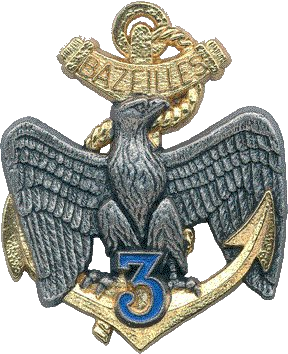
The 3rd Marine Infantry Regiment is a unit of the French Army in the French Forces. The 3e RIMa is one of the oldest of the troupes de marine. This regiment is one of the "Quatre Grands" of marine infantry once garrisoned within the four military ports, ready to embark : the « Grand Un », the « Grand Deux », the « Grand Trois » and the « Grand Quatre ». The « Grand Trois » has participated actively to the various far expeditions of the 19th century in Africa, the Americas, Oceania and the Orient. Surnamed also the "3rd Marine", the unit was part of the « Blue Division » which illustrated capability at the Battle of Bazeilles on August 31 and September 1, 1870. The regiment was subordinated to the 9th Marine Infantry Brigade.
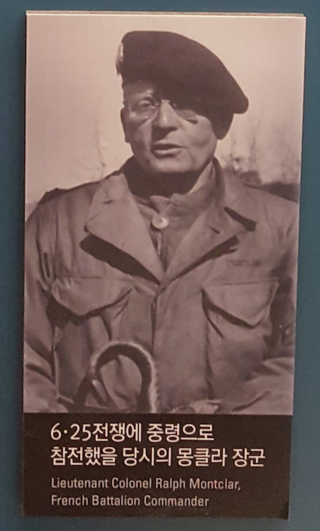
Raoul Charles Magrin-Vernerey, also known as Ralph Monclar was a French officer and 2nd Inspector of the Foreign Legion who fought in World War I, World War II within the ranks of the Free French Forces and led the French Battalion in the Korean War. He was also one of the first senior officers to respond to the Appeal of 18 June.

The 11th Marine Artillery Regiment (France) (French: 11e Régiment d'Artillerie de Marine, 11e RAMa) is an artillery regiment of the French Army. The regiment constitutes the fire support unit of the 9th Marine Infantry Brigade. The regiment employs around 950 men, fielding TRF1 155mm howitzers and MO-120-RT-61 120mm mortars. The regiment was founded in a third operational phase in 1951.
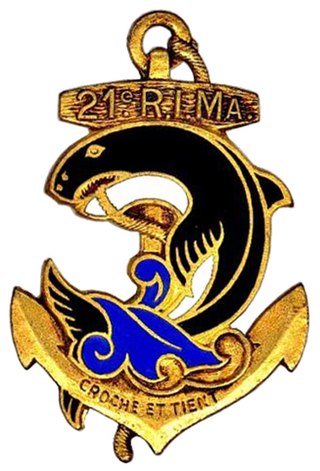
The 21st Marine Infantry Regiment is an infantry regiment of the Troupes de Marine issued by filiation from the 2e RIC.
37th Infantry Division was an infantry division of the French Army active during the First World War.
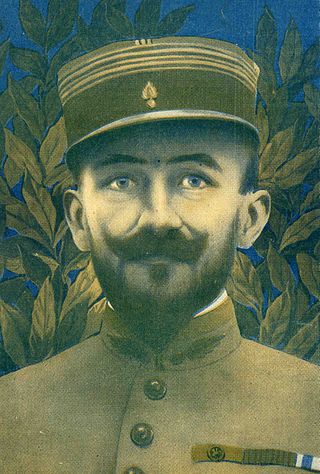
Paul-Frédéric Rollet (1875–1941) was a French Army Général who led in the Marching Regiment of the Foreign Legion RMLE, and was the 1st Inspector of the Foreign Legion, a post which he created under his intentions. Rollet accumulated 41 years of military service out of which 33 were in the Legion and also planned the 100th anniversary of the legion on Cameron day of 30 April 1931. Consequently, he was responsible for creating many of the Legion's current traditions.
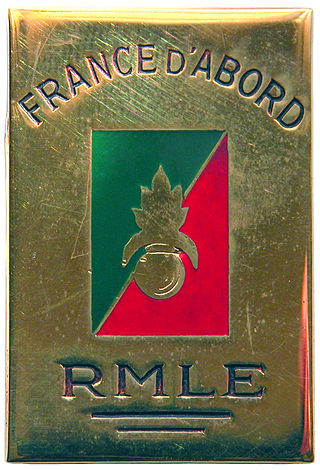
The Marching Regimentof the Foreign Legion (RMLE) was a French military unit that fought in World War I and World War II. Initially composed of marching regiments from the 1st Foreign Regiment of Sidi Bel Abbes and the 2nd Foreign Infantry Regiment of Saida, Algeria, it re-formed as the 3rd Foreign Infantry Regiment.
The Moroccan Division or the 1st Moroccan Division of 1914, initially the Marching Division of Morocco was an infantry division of France's Army of Africa which participated in World War I.
The 503e régiment de chars de combat 503e RCC in French, was an armoured tank unit of the French Army created on June 4, 1918 and which took part in the two world wars. The regiment merged with the 501e Régiment de chars de combat 501e RCC to form the 501e-503e Régiment de chars de combat 501e-503e RCC, a unit equipped with 80 Leclerc tanks. The regiment was dissolved on June 23, 2009.

The 8th Zouaves Regiment was an infantry unit of the French Army. Created in 1914, the unit was designated as 8th Marching Zouaves Regiment.

The 4th Tunisian Tirailleurs Regiment was an infantry regiment of the Army of Africa, part of the French Army.

The 3rd Algerian Tirailleurs Regiment was an infantry unit of the Army of Africa in the French Army. Recruited primarily from Algerian Muslims, it was mainly commanded by French officers. The racial boundaries were not absolute, with some French volunteers serving in the ranks and a limited number of Muslims being appointed as officers. After 1913 a selective form of conscription was applied to Algerian Muslims but the majority of Muslim soldiers serving in the 3e R.T.A continued to be voluntarily enlisted.


















